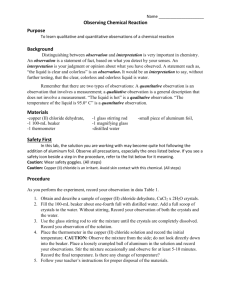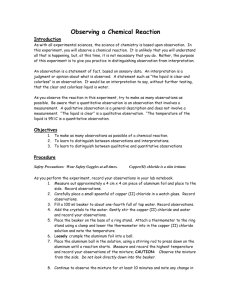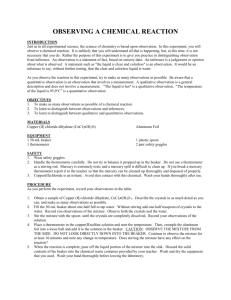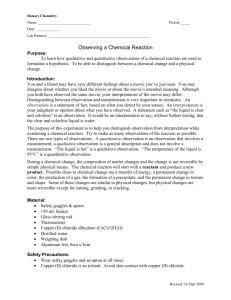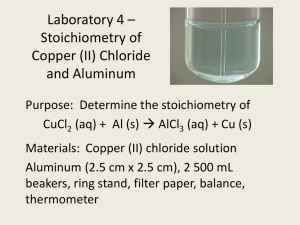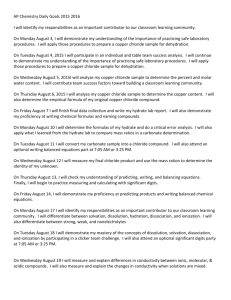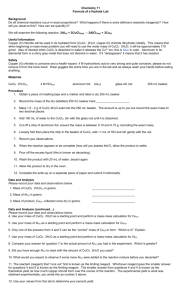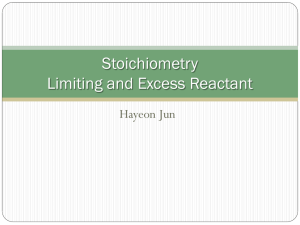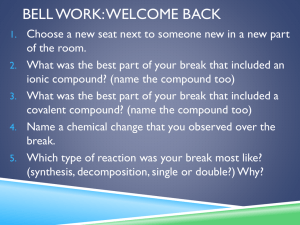File - Memorial HS Pre
advertisement
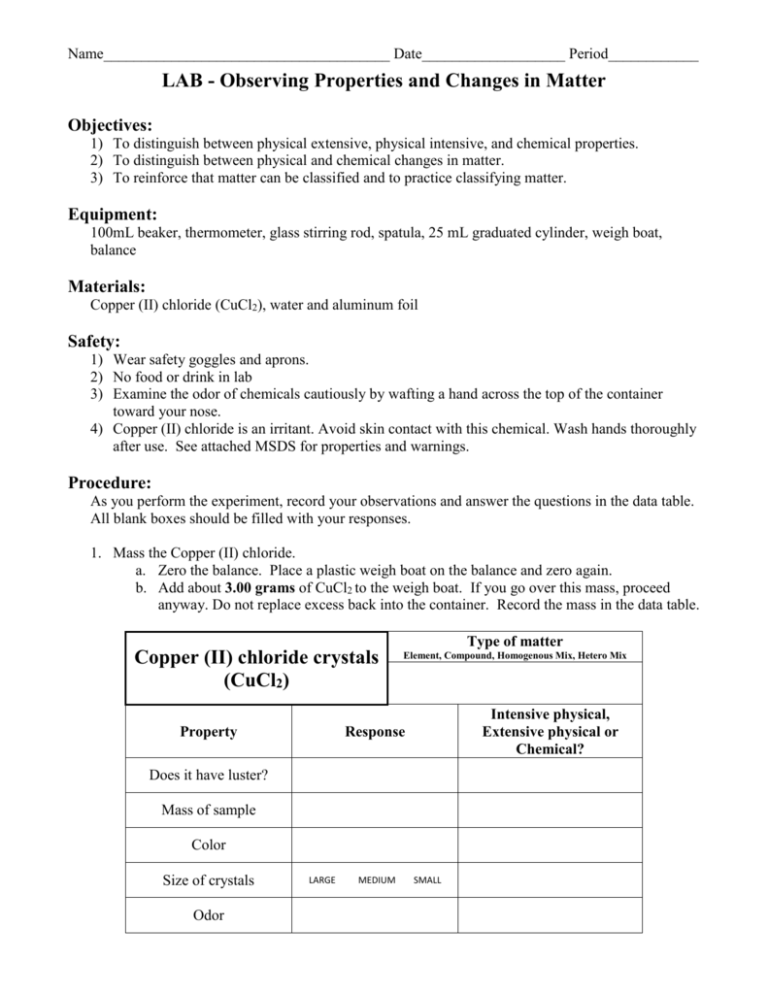
Name______________________________________ Date___________________ Period____________ LAB - Observing Properties and Changes in Matter Objectives: 1) To distinguish between physical extensive, physical intensive, and chemical properties. 2) To distinguish between physical and chemical changes in matter. 3) To reinforce that matter can be classified and to practice classifying matter. Equipment: 100mL beaker, thermometer, glass stirring rod, spatula, 25 mL graduated cylinder, weigh boat, balance Materials: Copper (II) chloride (CuCl2), water and aluminum foil Safety: 1) Wear safety goggles and aprons. 2) No food or drink in lab 3) Examine the odor of chemicals cautiously by wafting a hand across the top of the container toward your nose. 4) Copper (II) chloride is an irritant. Avoid skin contact with this chemical. Wash hands thoroughly after use. See attached MSDS for properties and warnings. Procedure: As you perform the experiment, record your observations and answer the questions in the data table. All blank boxes should be filled with your responses. 1. Mass the Copper (II) chloride. a. Zero the balance. Place a plastic weigh boat on the balance and zero again. b. Add about 3.00 grams of CuCl2 to the weigh boat. If you go over this mass, proceed anyway. Do not replace excess back into the container. Record the mass in the data table. Type of matter Copper (II) chloride crystals (CuCl2) Property Element, Compound, Homogenous Mix, Hetero Mix Intensive physical, Extensive physical or Chemical? Response Does it have luster? Mass of sample Color Size of crystals Odor LARGE MEDIUM SMALL 2. Fill the 100 mL beaker with 25 mL of water. Without stirring, add your 3 gram sample of copper (II) chloride to the beaker. Type of matter Copper (II) chloride crystals in water WITHOUT stirring Element, Compound, Homogenous Mix, Hetero Mix 3. Stir the copper (II) chloride and water together with the glass stirring rod until the crystals are completely dissolved. Place a thermometer in the copper (II) chloride solution and note the temperature in the data table below. Type of matter Copper (II) chloride crystals in water AFTER stirring Property Element, Compound, Homogenous Mix, Hetero Mix Response Intensive physical, Extensive physical or Chemical? Color of solution Is CuCl2 soluble in water? o Temperature of solution Question What type of change occurred when you added the CuCl2 to water? C Response PHYSICAL What evidence do you have? CHEMICAL 4. Obtain a 0.5 gram sample of aluminum foil using your digital scale. Form the aluminum foil into a ball. Type of matter Element, Compound, Homogenous Mix, Hetero Mix Aluminum foil Property Does it have luster? Mass of sample Color Is Al malleable? Response Intensive physical, Extensive physical or Chemical? 5. Place the ball of aluminum in the copper (II) chloride (CuCl2) and solution observe the mixture from the side. DO NOT LOOK DIRECTLY DOWN INTO THE BEAKER. Continue to observe the mixture and answer questions in the data table for 10 minutes noting any changes in temperature. Answer the questions that follow. Type of matter Copper (II) chloride crystals in water WITHOUT stirring Property Element, Compound, Homogenous Mix, Hetero Mix Response Intensive physical, Extensive physical or Chemical? Is CuCl2 reactive with Al Odor of the gas produced Color of solid product Color of remaining solution Highest temperature reached Question When the Al is added to the CuCl2, what type of change occurs? __________ oC Response PHYSICAL What evidence do you have? CHEMICAL What is the solid product that formed? 6. When the reaction is complete, pour off the liquid portion of the mixture into the waste beaker. Discard the solid contents of the beaker into the garbage. Rinse and dry the equipment used and clean your station to prepare for the next group. Wash your hands before leaving the lab. Material Safety Data Sheet (MSDS) Material Safety Data Sheet MSDS #: 281.05 SECTION 1 — CHEMICAL PRODUCT AND COMPANY IDENTIFICATION Copper(II) Chloride Dihydrate Health-3 Flammability-0 Reactivity-1 Exposure-1 Storage-1 SECTION 2 — COMPOSITION, INFORMATION ON INGREDIENTS Copper (II) chloride dihydrate Synonym: cupric chloride, copper dichloride CAS#: 10125-13-0 SECTION 3 — HAZARDS IDENTIFICATION Light blue-green powder or crystals. Odorless. Highly toxic by ingestion and inhalation. Irritant. Avoid all body tissue contact. 0 is low hazard 3 is high hazard SECTION 4 — FIRST AID MEASURES Call a physician and seek medical attention for further treatment, observation, and support after first aid. Inhalation: Remove to fresh air at once. If breathing has stopped, give artificial respiration immediately. Eye or External: Immediately flush with fresh water for at least 15 minutes. Internal: Rinse mouth. Give large quantities of water for dilution. Call a physician or poison control at once. SECTION 5 — FIRE FIGHTING MEASURES Nonflammable solid. When heated to decomposition, may emit chlorine. Fire Fighting Instructions: Use a triclass, dry chemical fire extinguisher. Firefighters should wear PPE and SCBA with full facepiece operated in positive pressure mode. SECTION 6 — ACCIDENTAL RELEASE MEASURES Restrict unprotected personnel from the area. Sweep up the spill, place in a sealed bag or container, and dispose. Ventilate area and wash spill site after material pickup is complete. See Sections 8 and 13 for further information. SECTION 7 — HANDLING AND STORAGE Flinn Suggested Chemical Storage Pattern: Inorganic #2. Store with acetates, halides, sulfates, sulfites, thiosulfates, and phosphates. Deliquescent; store in Flinn Chem-Saf Bag. Use and dispense in a hood. SECTION 8 — EXPOSURE CONTROLS, PERSONAL PROTECTION Avoid contact with eyes, skin, and clothing. Wear chemical splash goggles, chemical-resistant gloves, and chemical-resistant apron. Use ventilation to keep airborne concentrations below exposure limits. Always wear a NIOSH-approved respirator with proper cartridges or a positive pressure, air-supplied respirator when handling this material in emergency situations SECTION 9 — PHYSICAL AND CHEMICAL PROPERTIES Light blue-green powder or crystals. Odorless. Solubility: Water soluble and alcohol. Formula: CuCl2 2H2O Formula weight: 170.483 Melting point: 100 oC (decomposes) Specific gravity: 2.51 SECTION 10 — STABILITY AND REACTIVITY Avoid contact with moisture and alkali metals. Shelf life: Poor, deliquescent. SECTION 11 — TOXICOLOGICAL INFORMATION Acute effects: Toxic, irritant, and gastrointestinal disturbances. Chronic effects: N.A. Target organs: N.A. SECTION 12 — ECOLOGICAL INFORMATION Data not yet available. SECTION 13 — DISPOSAL CONSIDERATIONS Please review all federal, state and local regulations that may apply, before proceeding. Flinn Suggested Disposal Method #26a is one option. SECTION 14 — TRANSPORT INFORMATION Shipping name: Copper Chloride Hazard class: 8, Corrosive UN number: UN2802 SECTION 15 — REGULATORY INFORMATION TSCA-listed, EINECS-listed (231-210-2). N.A. = Not available, not all health aspects of this substance have been fully investigated.
